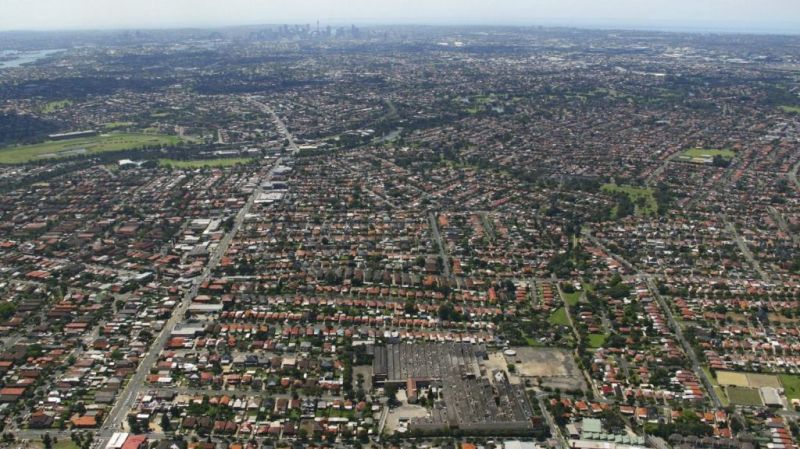If you’re looking for a new place to call home, the suburbs of Sydney have plenty to offer. The city’s outskirts are full of neighbourhoods that provide all the amenities you could want and more. Wondering where? We’ve got a list of some great places for you!
One of the most incredible things about searching for a place to live in Sydney is its suburban diversity.
Various choices, such as the charges, schools, sceneries, nature, safety, and transport, give you the privilege to select a place that meets your standards.
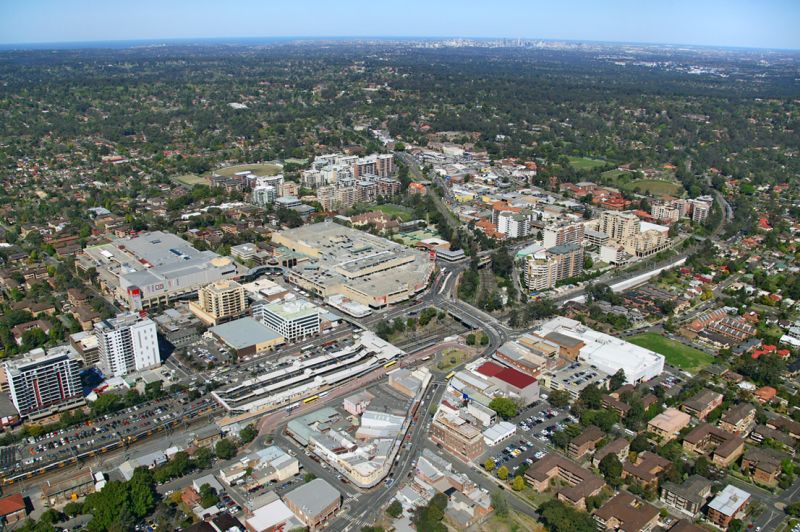
1. Hornsby
If you’re looking for a safe, green, and well-equipped suburb in the greater Sydney region to raise a family – without dropping millions of dollars on the property – then it’s hard to look past Hornsby.
Let’s get the obvious negative out of the way first: Hornsby is far enough away from the Sydney CBD to be pushing the boundaries of what most would consider “true Sydney”, but its good public transport connectivity helps alleviate this somewhat. However, you’re looking at around a 40-minute commute from Hornsby to Wynyard – 35 on a good day – and any train delays can blow this out drastically.
Hornsby’s rapidly growing population and desirability as a place to live also mean that traffic during peak hours has quickly deteriorated. A considerable quantity of commuters is cramming onto the already overpopulated roads that connect it to the city. It’s also a school-heavy suburb, so peak hour almost extends through to school pickup time as well.
Lastly, its large train station’s heavy use does not extend equally to the amount of parking on offer – especially since the suburb’s size means it’s a fair distance from many houses/apartments here to the station proper.
You’ll have a bit of a walk to the station if living on the suburb’s extremities, and it’s a pretty hilly suburb when crossing from east to west.
Still with us? Good – because other than this, there’s almost nothing else wrong with Hornsby, and if you look at the scores, you’ll see it’s currently sitting as the highest-rated all-around suburb on our list at the time of writing. There are multiple reasons for this, and they’re all good ones.
The first is the price. It’s no secret that property prices are one of the most distressing factors for those living in, or moving to, Sydney and its suburbs, and what you sacrifice in Hornsby for commute time comes back in return for affordable places to live.
While its ballooning popularity means it’s not as dirt-cheap as it once was, the ability to have a shot at a spacious, 3-bedroom freestanding home for under $1 million purchase price is a rare thing in a Sydney suburb that’s still safe and reasonably connected.
Sure, it might not be the most modern construction in the world – many of Hornsby’s cheaper properties are pretty old – but you’ll have a driveway to park your car and proper space for the kids and pets to play.
Likewise, for apartment buyers and renters, Hornsby’s is populated with a vast mix of new (mainly near the station) and old (further out) high-density apartment blocks with a massive variation in sizes, construction dates, and rental prices to choose from.
It’s this versatility that makes Hornsby so appealing; it’s not just that the suburb is so suited to families, but also that it’s suited to such a wide array of families.
This isn’t one of those Sydney suburbs that prices out those without ridiculously high salaries by default – there’s something here for almost everyone, with median rental prices hovering around $450 per week for a solid two-bedroom apartment.
And it’s not like you’re in some tumbleweed-filled backwater, either; Hornsby is stacked with amenities of all kinds for daily needs and entertainment.
The obvious starting point here is its Westfield – a massive shopping complex with almost every store imaginable; it also still retains some green elements in its surrounding arcade that’s quite nice.
Unlike other Westfields throughout Sydney, Hornsby’s is wider rather than taller and feels less concrete-jungle with outdoor play areas and dining mixed in. It’s a good hub area rather than just plopped in a dense city and a great place to shop as a result.
Elsewhere throughout the suburb, Hornsby is dense with small retailers and most big-box stores and outlets.
This extends to its restaurant scene; while Hornsby’s not renowned for being a culinary hotspot, there’s a wide enough range of dining that most major cuisines are covered, both near the station area and in its thoroughfare along Peats Ferry Road.
Hotels, RSL clubs, numerous cafes, Asian cuisine… it’s all here, and it’s all quite accessible. Unfortunately, it’s not much of a nightlife hotspot outside of the street and pub-type drinks. Still, there’s enough entertainment (including public sporting facilities, cinemas, etc.) to make it more interesting than some of the smaller, rich-and-green suburbs further down the North Shoreline.
The streetscape is thus friendly and varied between developed parts and greenery. Hornsby’s history also means it’s got some interesting older buildings mixed in for variety, too.
Its council building, courthouse, churches, and several other historic architectures combine with many trees to keep a suburban landscape from being too generic.
Hornsby is no slouch in the greenery department itself, either. But, despite this array of amenities, it’s also a highly green slice of suburbia with a massive amount of public green spaces.
Few suburbs can match the number of parks per capita, and nearly all of these are decked out in playground equipment for the kids.
This is a suburb that seems to have been specifically designed for those with kids in mind; you can’t walk around a block here without finding a great park, from the smaller grass-and-playground-only variety up to the larger James Park with its basketball courts, picnic and barbecue facilities.
The quantity of childhood education amenities in Hornsby reflects this as well. There’s a host of quality private, public, co-ed and single-sex schools in the area and plenty of daycare centres to cater to those with younger kids as well. In addition, its crime rate is low, and it’s peaceful throughout most of the suburbs other than the unit blocks closer to the train station so the little ones won’t get disturbed at night.
Add it all together, and you’ve got a largely self-sustaining suburb that can cater to families of all shapes, sizes, backgrounds and income levels.
Perhaps its only other flaw is a lack of significant white-collar employment opportunities; there are some larger-scale warehouses and light industry towards the North East, but most will have to commute elsewhere on the North Shore (e.g. North Sydney) or into the Sydney CBD proper.
Otherwise, Hornsby’s northern location means that you’ve got a lovely getaway option of the Central Coast and multiple National Parks within easy reach come weekends or school holidays, too.
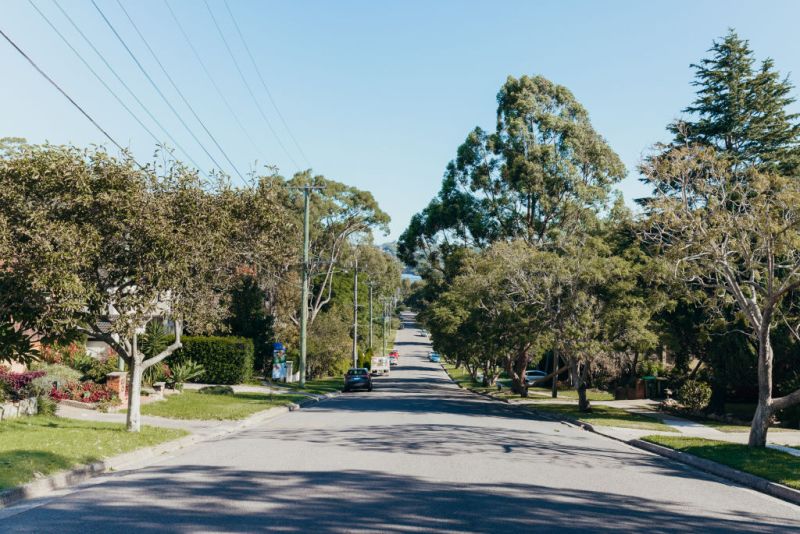
2. Oatley
If you’re the type who wants dashes of convenience – including a smattering of pretty good cafes, most essential services, and a reasonably large neighbourhood yet without crowds – Oatley delivers.
The suburb trickles out from its hub around the train station, where a few high-density, older apartment blocks can be found, and its main small shopping and dining strip offers a decent mix of cuisines and small-scale retail.
Its signature Oatley Hotel is a pub with a decent history and the focal point for what amounts to “nightlife” here. While it’s not precisely Newtown, it’s another feather in Oatley’s cap that most peaceful and green Sydney suburbs don’t have. The venue offers live music and some good pizza and draws plenty of visitors from surrounding suburbs and the greater St. George region.
And that’s about it in terms of man-made entertainment that Oatley offers; the majority of its things to see and do are courtesy of its natural environment.
It’s home to a range of wide-open and pleasantly green public park areas with both play equipment for families and some great views looking out over the Georges River. At the same time, its location offers pretty good access to the beaches of Cronulla and the like nearby as well.
One other notable aspect is Oatley’s excellent array of cycling tracks. The recently heavily-upgraded Oatley Park is an obvious highlight, with a significant aspect overlooking the water. Still, there are multiple potential routes on offer running through lovely green areas that aren’t too taxing even for the casual bike rider.
This greenery carries over to most of Oatley’s residential streets. They’re wide, green and leafy and feature some genuinely massive houses on big blocks, and there are chances at getting on-street parking here without a fight too. Waterfront views are on offer for the wealthy, with huge homes that come with a price tag to match.
Being one of the most desirable suburbs in its immediate area, buying here is far from cheap with Oatley carrying a premium price tag – but it also isn’t the stuff only of dreams like some equivalent suburbs on Sydney’s North Shore or the Eastern Suburbs.
Small-scale house prices here hover around the $1.5 million marks for purchase, which may be out of reach for many but still represents “fairly good” value close to Sydney city given the quality of lifestyle on offer.
Fortunately, its apartment rental prices are still reasonable. Several older buildings still in good condition offer not-too-shabby accommodations for under $500 per week; settle for something basic, and even $400 per week for a 2-bedder isn’t out of the question.
This makes for a pretty damn good compromise for those happy with downsizing their own living space in exchange for having plenty of open public spaces outside. It’s also not sacrificing size for a life-sapping commute and is worth considering for those who have perhaps moved to Sydney for the first time from a more country-oriented area.
It’s funny, but being over “this side” of the bridges of the Shire also has a kind of mental effect of feeling less isolated from Sydney proper. So while it’s only a short drive (or a couple more train stops), Oatley still feels more a part of “true Sydney” than some of its adjacent Shire suburbs.
Families, in particular, will benefit from calling Oatley home, as it’s got great public schools that are renowned for their achievements. Add in daycare and preschool opportunities dotted throughout – along with all these lovely, clean public play spaces – and both kids and dogs alike will likely find a lot to love living here.
For those who prefer a busier lifestyle, however, boredom may be a factor here. There’s not much in terms of attractions, and the extent of its shopping is primarily limited to supermarkets like Coles or Woolworths in nearby Mortdale. For larger-scale retail needs, you’ll likely want to make the 10-ish minute drive to Hurstville Westfield, not too far away.
Oatley also offers proximity to major toll roads that provide a springboard to elsewhere for those travelling by car. Lastly, one thing to note about its train station: while it sees many services closer to peak hours, you’re looking at half-hour intervals for trains arriving outside of this which can be a pain.
While it’s a pretty friendly community, many residents are long-termers, and the demographic trends are a bit older than many suburbs. As a result, younger professionals or uni students who have easy access to a thriving pub, dining or social scene will likely want to look elsewhere.
Oatley’s sure visually and naturally pleasant, but at its heart, it still is a little bit of conservative, bland suburbia for those who like things more alternative. However, for those who want stuff with a touch of extra grit (and save some more coin), neighbouring Mortdale, a.k.a “the poor man’s Oatley”, maybe more your speed.
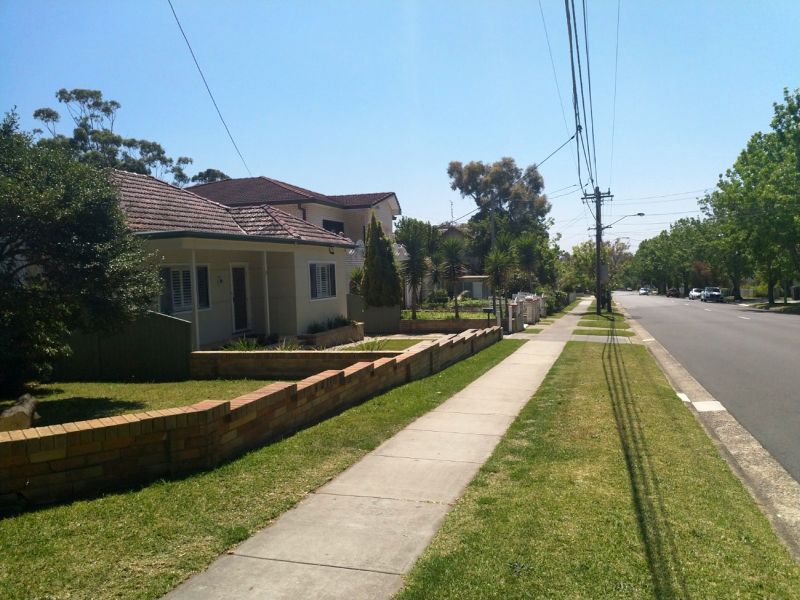
3. Jannali
As a whole, Jannali has to be one of the most well-maintained older suburbs that’s not out of the price range of mere mortals we’ve seen. There’s little to no graffiti, all the greenery and lawns are kept in excellent condition, and the majority of its homes boast lovely gardens.
Many of its houses sit on big blocks and offer ample living space, although many older-style apartment buildings are kept in good condition.
Although prices have climbed quite a lot since days past, they dropped again recently, and now it’s still highly affordable compared to many other suburbs both closer to the city and elsewhere in the Shire.
Quality 2-bedroom apartments can be had for around $450 a week rent, and the majority of its 3-bedroom freestanding homes still sit comfortably around the $900,000 mark.
That’s excellent value considering the level of livability on offer here. In addition, its recently-upgraded train station has express service connectivity that can provide a trip into the city in around 35 minutes, while the beach is only a 15-minute drive away, and Royal National Park and all of its lavish greenery is within easy reach as well.
This train connectivity is a massive advantage for Jannali over many other similar-demographic suburbs nearby (Bangor, Menai, Kareela etc.). It can make daily life for city workers much more bearable.
It doesn’t offer much in the way of bus connectivity; however, both its own streets and those leading to other suburbs are not too bad in the form of congestion. As a result, driving in and around Jannali isn’t nearly as painful as some of the Sydney suburbs further north over the Como Bridge.
While its main shopping strip is its only area of actual activity, it boasts a pretty good mix of small-scale services and shopping. There’s a medical centre, bakeries, dry cleaners, a few restaurants and fast food type spots (local, not big chains), as well as a handful of great little cafes. Then, of course, Woolworths/the Fleming Foods-signed store covers all your grocery needs, as well.
Sutherland’s a reasonably short drive away for bigger scale shopping opportunities, and the Union Place Hotel is a lovely new pub with a good selection of drinks right near the station as well. It added a much-needed dash of life to Jannali in a still-classy fashion without spoiling its overall atmosphere.
That’s about the extent of its amenities, however. This is not the spot for more extensive shopping trips or big-box retail in general, and there’s otherwise little nightlife to speak of.
Jannali’s streets are mainly broad and quiet, although there’s a bit of “dragging” that sometimes goes on towards the Como side of the suburb. It’s peaceful and green as a whole, with plenty of nature and birdlife around.
For a suburb with predominantly green streets, you’d think it would be park-rich as well, but it’s bizarrely not the case.
Jannali’s a bit lacking in parkland in general (unless you count Jannali Oval or the random ungroomed grassed area along Sutherland Road). While it’s pet-friendly mainly, there’s no actual “centrepiece” signature park that serves as a central outdoor meeting or picnic space. You have to head up to Como to get something a little more interesting in this regard.
While some parts of Jannali offer the chance at water views, it’s only a minimal slice of the suburb – and the amount that comes with the heftiest price tag.
It’s a great suburb for families in particular, however. Jannali is host to several quality, easily accessible public schools, and there’s also a community college for further education opportunities.
That’s pretty damn good for a reasonably small suburb and combines with the chance at extra living space and a safe community as a whole to make for a great place to raise kids.
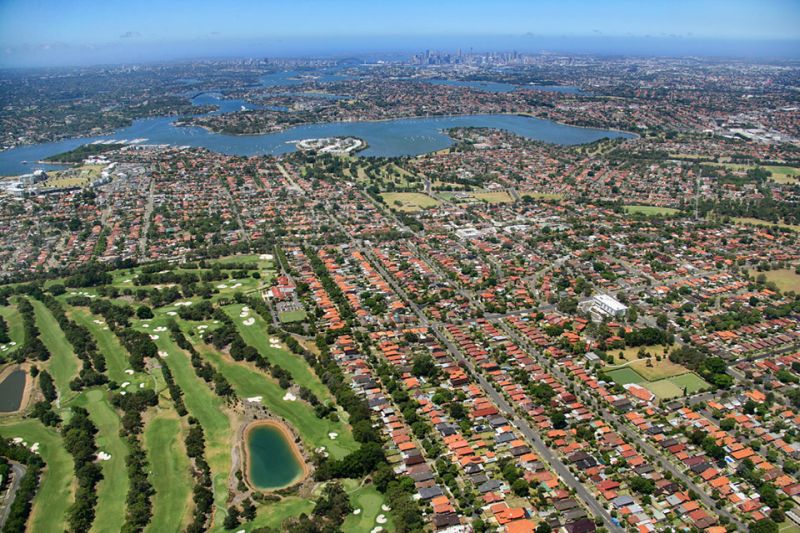
4. Concord
Spacious and affluent, Concord is one of the most visually impressive purely residential suburbs in inner Sydney. There seems to be an overall attitude towards pride in presentation throughout the suburb, as everything is immaculately groomed, painted, and maintained.
This applies regardless of if the home is an older or newer construction – the often-spectacular modern houses here obviously shine. Still, the older ones have, on the whole, been kept in remarkable condition as well.
Clean, comprehensive and peaceful back streets are dominated by large low-density homes that lie on impressively large blocks, with almost every front garden wonderfully kept and striking somehow. Concord is also very green overall, and its greenery comes in a variety of forms.
Two extensive golf courses, multiple great parks, tree-lined streets and even sections of mangrove forest all provide a diverse botanical landscape that makes Concord’s air and streetscape feel refreshing. This all comes without sacrificing too much distance from civilization, either.
While Concord does not have a dedicated rail station – both Concord West and Strathfield sit just outside the suburb’s extremities and can be a bit of a hike to get to unless you live on one of the suburb’s perimeters – the Sydney CBD isn’t too massive a journey.
Its physical location means that Concord sits on sort of a “crossroads” of Sydney’s overall layout, with both the west and east within striking distance instead of leaning too far in one direction.
Concord’s well-serviced by buses in both directions and has plentiful stops dotted throughout its residential streets. Moreover, its infrastructure is only set to continue expanding. The upcoming Metro West is set to provide proper rail connectivity that should see commute times of an incredible 20 minutes into the city.
For drivers, its proximity to major arterial roads also helps, although they’re prone to the same congestion during peak hours that hit most of inner Sydney. For example, noisy and strained Parramatta Road provides city access and a thoroughfare to the west. At the same time, Concord Road is the pathway past Homebush and over the Parramatta River to the north shore.
It’s pretty remarkable how much living space the suburb offers, particularly compared to some of its neighbouring inner west suburbs not too far away.
It’s a suburb of almost entirely low-density freestanding homes with multi-car garages, extensive gardens and backyards, and streets that provide plenty of spots to park a car on-street for visitors instead of the eternal parking-spot-hunt many other suburbs require.
Its park spaces are impressive as well. There are multiple sporting fields at the likes of Ron Routley, St Lukes and Concord Ovals as well as Rothwell Park, while Edwards (playground equipment) and (especially) Queen Elizabeth Parks (walking tracks, dense trees & more) are additionally extensive and high-quality public spaces for pets and kids.
Concord is highly pet-friendly overall and ranks high on our list for this as far as Sydney suburbs go. Its propensity for big yards, multiple parks, vet hospital, and pet supplies combine to make for some truly happy doggies, and the vast majority of its streets are healthily tree-lined and grassed to boot.
Families will likewise be in their element here, and this is the main target demographic who will want to call Concord home. It’s both home to – and fringed by – multiple private and public schools for all ages, as well as several kindergartens and daycare centres.
Add in its high level of safety/low crime rate and the parks above, and you’ve got a great family all-rounder.
“What I like most is the overall family orientated lifestyle. Also, the open spaces for walks and play with the bay being close by,” says Amanda Tasovski, a Concord resident.
“There are so many local choices for excellent eating out. The whole suburb has such a nice community feel and vibe. I also really love how neat and clean the area is.”
Unlike some other purely-residential suburbs, Concord’s also not lacking in quality amenities. On the contrary, its central retail/dining hub, concentrated around Wellbank Street and Majors Bay Road, is surprisingly well-equipped, both for shopping and dining needs.
This is a charming and communal gathering area that’s again very well-maintained and looked after.
The suburb’s Italian heritage still shows several quality Italian restaurants and cafes, while central banks and other essential services can be found here.
There’s a Coles for supermarket needs, although it lacks department stores or similar big-box retail. Its back streets elsewhere in the suburb are also sporadically populated with the occasional fish & chip store, boutique or newsagent to keep things interesting.
Concord is very family-oriented and much more for professionals and even retirees than it is partygoers. This is not a “nightlife” suburb, although there are a few decent bars/inns to enjoy a drink on the suburb’s extremities.
All of this cavalcade of positive aspects in Concord is obscured by two main factors directly related to one another.
The first is its lack of high-density housing options. As mentioned before, much of Concord’s appeal comes from its big houses and living space – there’s a distinct lack of even low-rise apartment blocks here, and this limited supply mostly means it’s house-(or at least townhouse/duplex)-or bust for those wanting to live here.
That ties directly into the suburb’s high property prices. There’s almost no more minor, pokey/starter-level houses here – it’s going big, or go elsewhere. While that’s all well and good for those with bottomless pockets (and it could be argued the main reason the suburb’s kept so pleasant), it doesn’t change the fact that it makes a living here unrealistic for a large portion of the population.
Kudos to those who bought property here back when it was more reasonable, as its desirability along with the upcoming infrastructure projects (not only the Metro but WestConnex as well) means prices have soared.
$1.6 million+ property prices are a baseline for freestanding houses in Concord, with many of the newer constructions far exceeding this as well. $2.5 million price tags aren’t uncommon, and while you’re getting a lot of house for that figure, it’s still a number that’s out of reach for many.
What apartments are available to rent aren’t too bad by Sydney standards at around $500 per week for a two-bedroom rental; it’s just that their limited supply means choices and availability aren’t as diverse as one may like.
It’s no surprise that those who have homes here tend to clutch to them tightly, as the suburb’s one main downside – connectivity – is soon to be addressed as well.
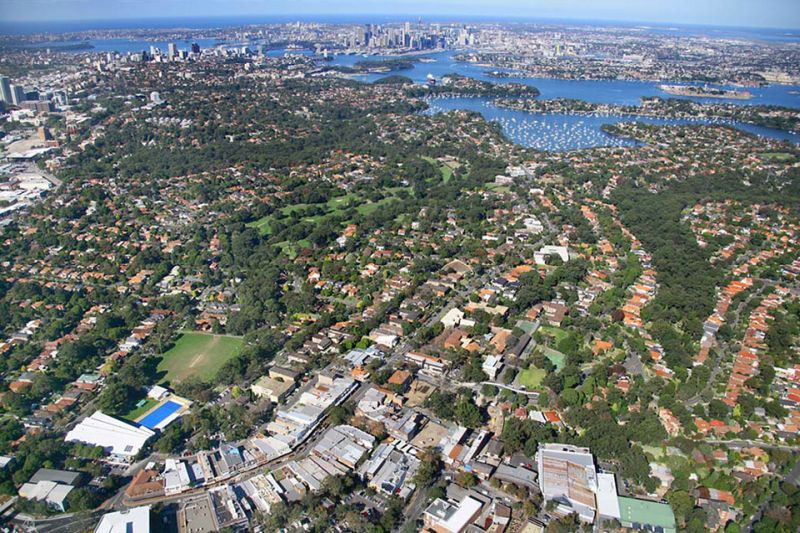
5. Artarmon
If we will use a single word to describe Artarmon, “versatile” would likely be it.
The way it walks the line between so many different aspects of Sydney’s other suburbs – bigger heritage houses draped in greenery with higher-density affordable housing on the other side of the track, blue-collar working opportunities nearby or white-collar a couple of train stops away, schools, furniture stores, et al. – means it can come recommended for any family size or demographic.
Perhaps its only real “downfalls” would be that its landlocked nature means there’s no waterfront and an increased distance to a beach, its more extensive housing can be pricey. In addition, a lack of any major retail shopping and attractions makes it more “utilitarian” than “fun”.
But for daily life, however, these will likely be of little concern – and it’s everywhere else that Artarmon shines.
Its central location – well, primary for the North Shore – is an easy starting point. Not only does its train station see regular services, but it lies in a position that grants Artarmon good central road connectivity that allows access to major arterial roads running in every direction.
Retail shopping (Chatswood), drinking and dining (Crows Nest), and business/work (North Sydney) opportunities are all within easy reach of Artarmon, with traffic around the suburb and its back streets also typically not too bad given the amount of population in this region.
Hop on the train, and it’ll only take you around 20 minutes into the Sydney CBD as well.
Within the suburb itself, each side of Artarmon (referring to the east and west sides of its train tracks) shows a very different side of the same coin. So this is a suburb with “two faces” in that it’s completely different from one side of the station to the other.
As a result, it’s got something to offer both cashed-up buyers looking to snag a heritage home on a lovely, leafy street, while those who prefer more of an apartment-based high-street style lifestyle are catered for as well.
On the track’s east side, its freestanding homes are mostly older, large and stand on surprisingly big blocks. Many are heritage protected, and its peaceful streets with large trees overhanging lend an aura of tranquillity.
The properties here boast quite a bit of space, and their desirability and relatively limited number make them tightly held, with a pretty slow-moving real estate market as a result. Even smaller and “plain” standalone houses aren’t cheap, and you’re looking at around a $2 million barrier to entry.
On the west side, you’ve got an array of smaller retailers, bakeries and various shops run by a mix of nationalities. This little “high street” harks back to the older days of Sydney suburbs and feels entirely communal, although it doesn’t stretch for very long or have the most incredible depth of store types.
Behind these sit a range of apartment buildings that offer some pretty damn affordable accommodation, given it sits in a significant spot on the North Shore line for a roughly 15-minute train ride into Sydney city.
If you’re willing to go a bit older in terms of property construction date, even a two-bedroom apartment for $450 per week rental is doable. Sure, the fixtures, carpet and similar may not be the most modern, but the structures themselves are typically rock solid.
One of the most unusual aspects of Artarmon is its disproportionately high Japanese population. Head just under the tunnel outside the station, and you’ll find a tiny enclave of Japanese-style restaurants, including cafes, ramen restaurants, and even a couple of specialty Japanese mini-marts selling all kinds of imported snacks and ingredients.
It’s an amiable vibe and highly pleasant to hang out in and chat, and something slightly different elsewhere on the North Shore.
Elsewhere in the suburb, the scale of things increases – there’s hospitals, more oversized furniture and pet superstores, and a range of warehouse-style outlets and car dealers that help round things out. But, unfortunately, the end of the shopping scale at Westfield Chatswood is also just a short trip away.
It’s quite a pet friendly, with generally green streets and a couple of notable reserves providing open spaces for animals to do their thing and a quality veterinary hospital for pet care and checkups when needed. Add in quality public school options for the kids, and Artarmon’s amenities cover all the bases for most household demographic combinations.
It’s also fairly decent in terms of driving given its scale, as the North Shore, in general, is far less hectic than its bigger brother over the water.

